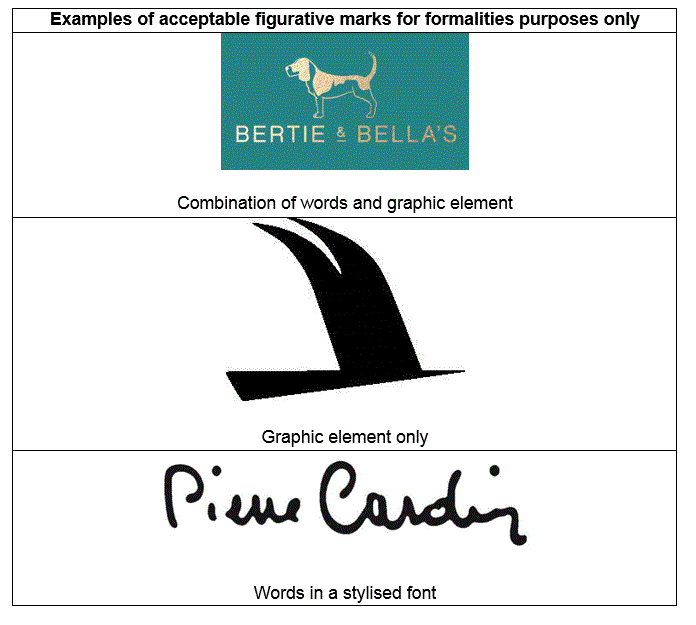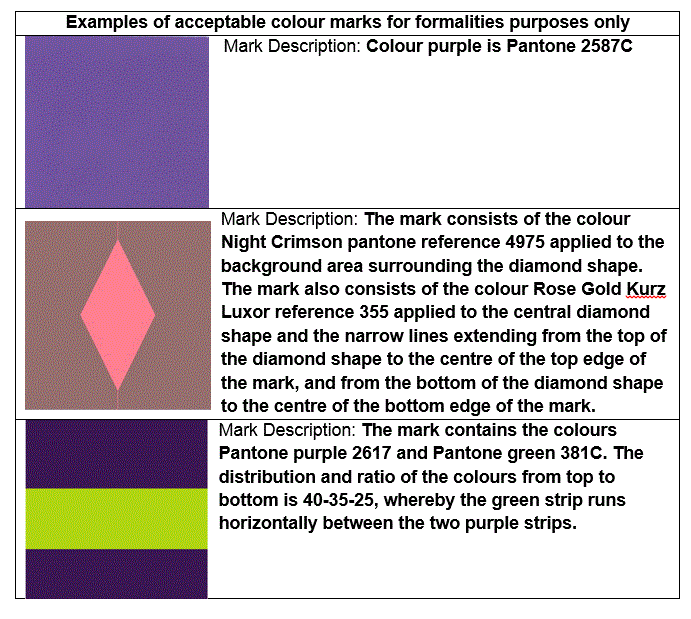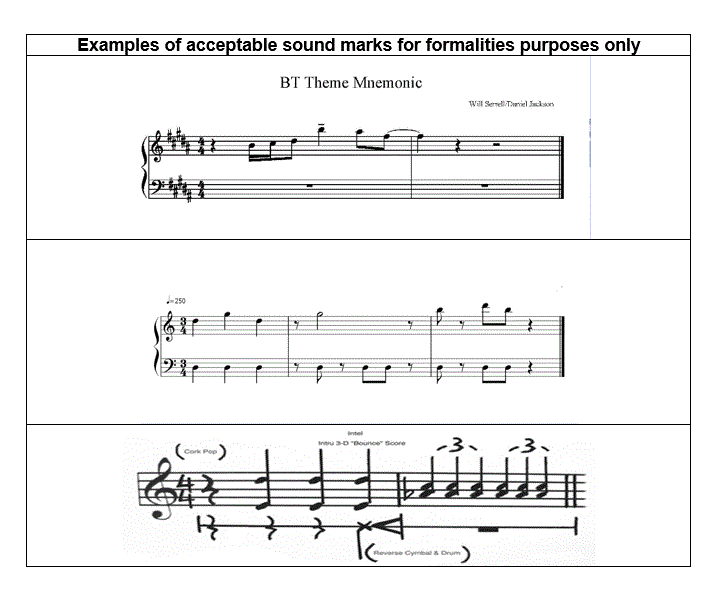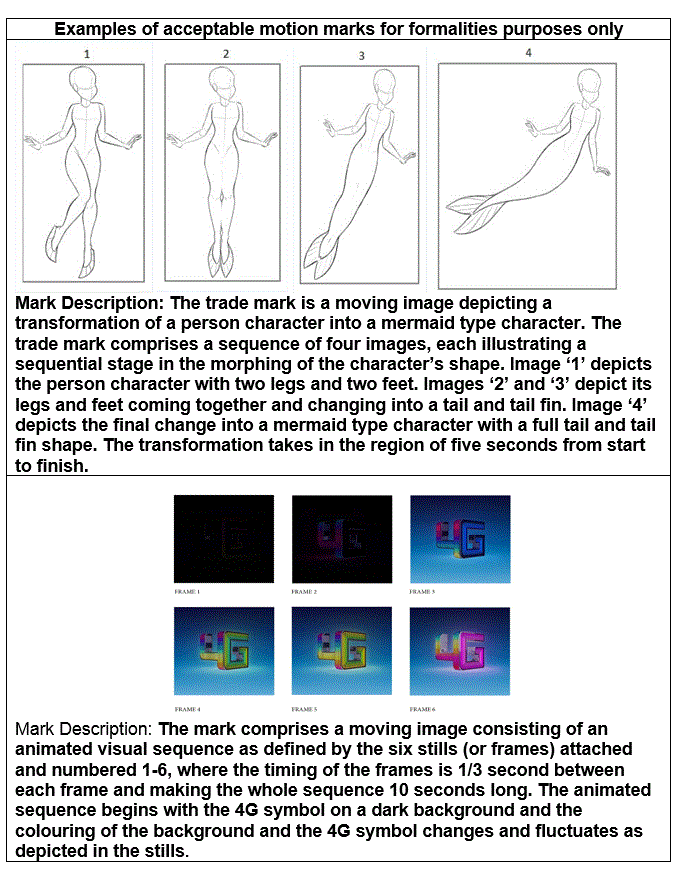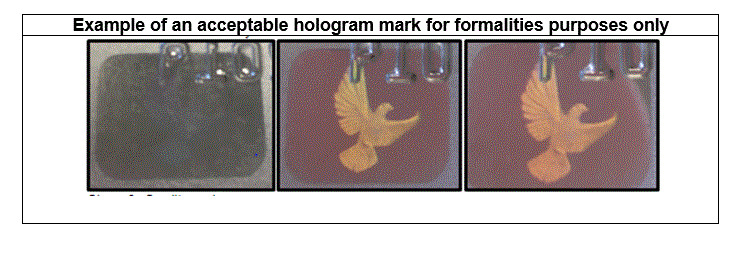New applications
Section last updated: January 2021.
We check every application to make sure that it meets the requirements for filing stated in the Act and Rules. Some requirements are essential in order to obtain a filing date. Others are not essential for filing date purposes but must still be met before we can send an application on to examination. If the requirements have been met, the filing date is the date when we received the application. If the filing requirements have not been met, the filing date will be the date when we receive the last document which puts the application in order. This is set out in S.33(1) of the Act.
1.1 Essential requirements for filing date - Section 32(2) of the Act
We give an application a filing date as soon as all the essential filing requirements are met. These are as follows (the paragraph letter corresponds to that in Section 32(2)):
a. a request for registration of a trade mark.
A request for registration is generally taken to be the provision of form TM3 which in itself is a request for registration. However, if we get a letter which clearly states that a request for registration of a trade mark is sought, this would be sufficient to meet this requirement.
b. the name and address of the applicant.
The full name and address of the applicant (who becomes the ‘proprietor’ once the mark is registered) must be supplied. The name of the applicant must be the correct legal name (particularly in the case of companies) and not a trading name or style. Further guidance on the acceptability (or otherwise) of certain types of applicant is given in paragraph 3 below.
c. a statement of the goods or services for which it is sought to register the trade mark.
An application must include a list, or statement, of all goods and services (the specification) for which an applicant uses or intends to use the trade mark. It is not essential to provide a class number in order to obtain a filing date, but this is a requirement which must be met before the application can proceed further. The specification will not be examined in any detail at this stage; a detailed examination will be made by a trade mark examiner, but if the specification is not clear we will contact the applicant to clarify the specification.
d. a representation of the trade mark
A representation of the mark (or marks in the case of a series) in the format that registration is sought must be provided.
1.2 Non-essential requirements for filing date
1.2.1 Use or bona fide intention to use - Section 32(3)
Every applicant must be either currently using the trade mark (or allowing someone else to use it with their consent) or have a bona fide (good faith) intention to use it in relation to the goods or services requested. The declaration on the application form, stating this, must be signed by the applicant or their representative.
1.2.2 Application fee and class fees - Section 32(4) and Rules 5 and 13
The applicant must pay a basic application fee covering the first, or only, class in the application. If further classes are requested, each extra class is subject to a class fee. As this requirement is not essential for filing date purposes, payment does not have to be sent with the application form.
1.2.3 Form TM3 to be used - Rule 5
If we get a request for registration of a mark which contains all the essential requirements for allocation of a filing date, we will allow one month for these details to be transferred to an official application form TM3, or an acceptable replica of that form (Rule 3(2)), and for this form to be returned.
1.2.4 Application to specify the class - Rule 8(2)
The application must specify the class of the “Nice” classification system, as set out in Schedule 3 of the Rules, to which it relates. This is used to allocate class numbers to the specification.
1.2.5 Address for service
Applicants shall provide an address for service in the United Kingdom, Gibraltar or the Channel Islands.
1.3 Dealing with deficient applications
If any filing requirements are not met, we send the applicant a letter, stating why the application is not acceptable and allowing one month to remedy the deficiency. This letter is issued under the provisions of Rule 13, or Rule 11 in the case of lack of an address for service in the UK.
If the deficiency is not remedied within the one month period, the application will either be:
- deemed never to have been made, in respect of essential requirements; or
- treated as withdrawn, in respect of requirements which are not essential for obtaining a filing date
Note: The one month period runs from the date we issue the deficiency letter and cannot be extended (Rule 77).
2.1 Inconsistencies in the application form
We check to make sure that information on the application form is consistent and logical.
Common errors include:
- number of marks in the series differs from the number of marks provided;
- discrepancies between the words in the representation of the mark and the words entered on the form;
- inaccurate priority claim, for example, based on earlier UK filings;
- a statement that the mark is a certification or collective mark but does not appear to be so;
- obvious errors in the mark or specification; and
- mark type, if stated does not match the mark
We try to resolve most inconsistencies by a phone call, primarily as a matter of customer care, to the applicant or their representative. However, it is the responsibility of applicant to ensure that they have completed their application form correctly.
2.2 Mark type
A mark type must be allocated to every application. This establishes what the applicant is seeking to register and it is also an administrative action which aids in the search for similar marks. If the mark type is unclear from what has been entered by the applicant on the application form, we will resolve this before we record the information on the application record. We may refuse requests by applicants to correct this information at a later stage
If the application is for a series of marks, the mark type should be the one which describes the most complex mark in the series.
| The mark types are: | Acceptable file format |
|---|---|
| * word mark | Text |
| * figurative mark | JPEG, JFIF |
| * 3D mark | JPEG, JFIF, OBJ, STL and X3D |
| * pattern mark | JPEG, JFIF |
| * colour mark | JPEG, JFIF |
| * sound mark | MP3, JPEG, JFIF |
| * motion mark | MP4, JPEG, JFIF |
| * multimedia mark | MP4 |
| * hologram mark | JPEG, JFIF, MP4 |
2.3 Representations of the mark
The applicant must provide a representation of the mark in order to secure a filing date (Section 32 (2)(d) refers). Marks should be presented in a way that is clear, precise, self-contained, easily accessible, intelligible, durable and objective manner so as to enable the competent authorities and the public to determine with clarity and precision the subject matter of the protection afforded to its proprietor. If this is not the case, we will raise this as a deficiency with the applicant.
If the representation filed is not acceptable we will write to the applicant, allowing a period of one month for an acceptable representation to be filed. If an acceptable representation is filed within the one-month period, the filing date will be the date when we receive the satisfactory representation. If the deficient mark is one of a series of marks, an instruction to delete the offending mark within the one-month period will be sent to the applicant. This will allow the application to keep the original filing date.
If the offending mark is not deleted, we will deal with the application as described in paragraph 1.3 above.
2.4 Guidelines for Mark Types:
2.4.1 Word marks
A word mark is a typewritten mark consisting of standard typographic letters or numerals. The sign must be submitted in standard lay out and font without any graphic feature, colour or stylisation. If the sign does contain any of these features then it should be classified as ‘figurative’
Examples of acceptable word marks for formalities purposes only
Happy Valley
To me 2 u
#purple elephant
2.4.2 Figurative marks
A figurative mark can consist exclusively of a figurative image, or a combination of verbal and figurative elements. A mark is also classed as figurative if the verbal elements are in colour or are presented in non-standard characters. If a mark is shown in colour, the mark will be registered in these colours. Other than in the types of trade mark described in paragraph 2.4.5, there is usually no need to provide a written description of the colours that appear in a trade mark consisting of a picture or a device (but see paragraph 2.3 above for details on the need for marks to be intelligible). If written colour identification codes are included in the application they will be recorded as part of the representation of the trade mark.
If a mark is shown in black and white, we will not consider these colours as a feature of the mark unless the applicant states otherwise in which case the trade mark will subsequently be published and registered with an indication that the colours black and white are a feature of the trade mark.
2.4.3 3D Marks
A 3D mark is one consisting of, or extending to, a three-dimensional shape, this includes representations of containers, packaging, the product itself or its appearance. The shape can be represented by a graphic representation or a photographic reproduction or a computer- generated image in 3D format in OBJ, STL or X3D, with a maximum file size of 20 MB.
If the representation is not a computer-generated image, it may be difficult to represent the shape by a single front view which may not show whether it has a round profile or is four sided. Unless the mark can be represented by a single perspective view, multiple views of the shape are necessary (no more than six as a general rule). The more complex the shape, the more likely it is that multiple views will be necessary. While different perspectives may be filed, a single view of the shape is sufficient where the shape to be protected can be ascertained from that single view.
If the elements for which protection is sought can be made out it will not usually be necessary to confirm that the shape would appear the same from other views. The same applies to three-dimensional marks incorporating labels. It is assumed that only those features visible from the representation form part of the subject matter; whether a container has another label on the back is irrelevant.
Applicants applying for registration of a 3D shape mark must indicate this in the application. If no mark type is indicated and only one view has been submitted, from which it cannot be inferred that the sign consists of or extends to a 3D shape, the Office will treat the representation as a figurative trade mark.
2.4.4 Pattern marks
A pattern mark is a trade mark which consists exclusively of a set of regularly repeated elements.
The marks must be represented by submitting a reproduction showing the mark and a description detailing the nature of the regularly repeated elements. The description must reflect the representation and not extend its scope. Should colours form an integral part of the mark they can be indicated within the description.
2.4.5 Colour Marks
A colour mark is a mark which consists exclusively of a colour in the abstract or a combination of colours. What is protected is the shade of colour(s), or in the case of more than one colour, ‘a systematic arrangement associating the colours in a predetermined and uniform way’- see Heidelberger Bauchemie GmbH, ECJ case C-49/02. So, for example, where a mark consists of colours used in various applications, but always as stripes, the representation of the mark should indicate that the colours (as properly defined) are used as stripes and must indicate the order in which the colours appear in the stripes, for example, blue, then red, then green.
Marks consisting exclusively of a colour or colours must be represented by giving a written description of the colour(s), for example, dark blue and light green, in the box on the form and by stating what those colours are, using an internationally recognized colour identification system, such as Pantone®, Focoltone®, Munsell Color® or Toyo®.
Where marks consist of a colour or colours applied to the goods or their packaging, or to other commercial items, an appropriate description should be included as part of the representation of the mark. Where colour is applied to the whole, or substantially the whole, surface of the item in question, a statement to this effect will suffice. In other cases a picture or diagram may be necessary to identify the area(s) of the item to which the colour or colours are applied.
If the representation contains other elements, such as words, it is not a colour mark per se but a figurative mark.
2.4.6 Sound Marks
A sound mark is as a trade mark consisting exclusively of a sound or sounds. Sounds marks can be of musical scores or of other sounds such as people speaking or singing or the noise of animals.
A sound mark must be represented by submitting an audio file reproducing the sound, with the exception of tunes and melodies which can either be submitted as an audio file or an accurate representation of the tunes or melodies in musical notation. The audio file must be in MP3 format and its size cannot exceed two megabytes. Office requirements do not allow the sound to stream or loop. An audio file may be submitted only for by e-filings. The Office will not accept a paper filed application with your mark accompanying it on a physical data carrier, like a USB stick.
Musical notations may be submitted in one single JPEG file or on one single A4 sheet. ‘Accurate musical notation’ means that the representation must include all the elements necessary for interpreting the melody, that is to saysuch as, pitch, tempo, lyrics (if any), etc. Applications for sound marks in musical notation must clearly state that they are sound marks, otherwise the application will be examined as if it were a figurative mark.
Marks which combine sounds with, for example, movement would not qualify as sound marks per se and should be applied for as a multimedia mark.
2.4.7 Motion marks
A motion mark is as a trade mark consisting of, or extending to, a movement or a change in the position of the elements of the mark. A motion mark must be represented by submitting either a video file or a series of still sequential images showing the movement or change of position. The video file must be in MP4 format and may not exceed 8 000 Kbps (kilobytes per second) and 20 MB.
In respect of applications filed with a series of still images, the number of images is practically unlimited as long as they all fit in one single JPEG file or on one single A4 sheet. A mark description must accompany the still images and must include:
- what the image depicts, that is, what the change in appearance is;
- how many images are involved in the complete sequence of movement;
- what the sequential order is of the images; and
- that there is a single sequence of movement (not variable)
Such a description must accord with the representation and not extend its scope. Colours, to the extent that they form an integral part of the mark, may be indicated therein.
There is no requirement to submit a mark description if the mark is submitted as a video file. Trade marks combining movement with sounds do not qualify as motion marks and should be applied for as a multimedia mark. A video file may be submitted only for by e-filings. The Office will not accept a paper filed application with your mark accompanying it on a physical data carrier, like a USB stick.
2.4.8 Hologram marks
A hologram mark is a trade mark which consists of elements with holographic characteristics. A hologram mark must be represented by submitting either a video file or a graphic or photographic reproduction containing the views necessary for sufficiently identifying the holographic effect in its entirety.
The video file must be in MP4 format and may not exceed 8 000 Kbps (kilobytes per second) and 20 MB. A video file may be submitted only for e-filings. The Office will not accept a paper filed application with your mark accompanying it on a physical data carrier, like a USB stick. The number of views is unlimited as long as they all fit in one single JPEG file or on one single A4 sheet.
2.4.9 Multimedia marks
A multimedia mark is defined as a trade mark consisting of, or extending to, the combination of image and sound. The term ‘extending to’ means that the mark may also include other elements including but not limited to words, figurative elements, and labels in addition to the image and sound.
A multimedia mark can only be represented by submitting an audio-visual file containing both the image and the sound and can therefore only be filed via e-filing. The Office will not accept a paper filed application with your mark accompanying it on a physical data carrier, like a USB stick. The audio-visual file must be in MP4 format and may not exceed 8 000 Kbps (kilobytes per second) and 20 MB.
2.5 Series
An application can be filed as a series of marks. A series of marks means a number of trade marks which resemble each other as to their material particulars and differ only as a matter of non-distinctive character which would not affect the identity of the trade mark. An application can include a maximum of six marks. The first and second marks are included in the application fee, any additional marks would attract a fee.
For a series to be acceptable, the marks should:
- look the same
- sound the same
- mean the same
Any differences must be minor.
A registered trade mark and an application for registration are both personal property (Sections 22 and 27 refer). This means that an applicant must be an individual (a natural person) or some sort of legal person, capable of owning property in their own name.
Where there appears to be some doubt as to an applicant’s legal status, we may ask for confirmation that the applicant has the necessary standing to hold property. If the application is made on behalf of an unincorporated association, it is important to remember that the association as such may not be capable of owning the application or the trade mark: unless the association is in the nature of a partnership, this can only be done by specified persons acting as trustees for the association. Similarly, an application on behalf of an unincorporated charitable trust must be made by the trustees. An application in the name of a body calling itself a ‘trust’ or a ‘club’ is liable to give rise to such a request for clarification.
We use the following guidelines when considering whether to question the legal status of an applicant:
Individuals
The applicant should include their full name. For example, if the individual was named John Smith they should enter that on the form. Only entering part of the name such as John, or J Smith is not acceptable and will result in a deficiency letter being issued to the applicant.
Companies/corporate bodies
Any form of company, that is, a business incorporated into a legal entity as distinct from its members or directors, is capable of holding property in its own name. This should be the full company name including any suffixes. For example, in the case of a UK private limited company the name supplied should contain ‘LTD or ‘Limited’ i.e. if the name registered at Companies House is ‘Team 1 LTD’, this should be entered on the form. If only ‘Team 1’ is entered this will not be accepted and will result in a deficiency letter being issued to the applicant.
Partnerships
Partnerships (including limited liability partnerships, partnerships governed by an agreement and partnerships at will) are allowed to be recorded as applicants. If the applicant is a partnership, we will require that this be stated in the application, after the name of the partnership, for example, `Boggles (a partnership)’. In the case of a partnership at will, it is necessary to list the partners who make up the partnership because (in the absence of an agreement) the legal personality of the proprietor will change every time a partner changes.
Other unincorporated bodies
Other unincorporated bodies such as trading names do not have the capacity to hold property in their own name.
Trustees
Where an application is made by a trustee or trustees, for the benefit of another person (or body of persons), it should be noted that only the name of the trustees will be entered on register. That is because Section 26 prohibits the entry of merely beneficial interests. Accordingly, the register will contain only the name of the legal owner of a mark, even where the beneficial owner is another person or body.
Furthermore, that will still be the case, even where the beneficial owner is itself a person capable of owning property in its own right. Thus, wherever it is intended that the trade mark is to be held on trust for someone other than the legal owner, that legal owner (the trustee), rather than the beneficial owner (the person for whom the property is held), should be listed as the applicant.
Registered charities
The mere fact that an organisation is a registered charity may not entitle the organisation to hold property; some other form of legal personality may be needed before it possesses property holding powers. However, the Registrar will accept an assurance from the filer that a registered charity has the necessary status to hold property in its own name.
